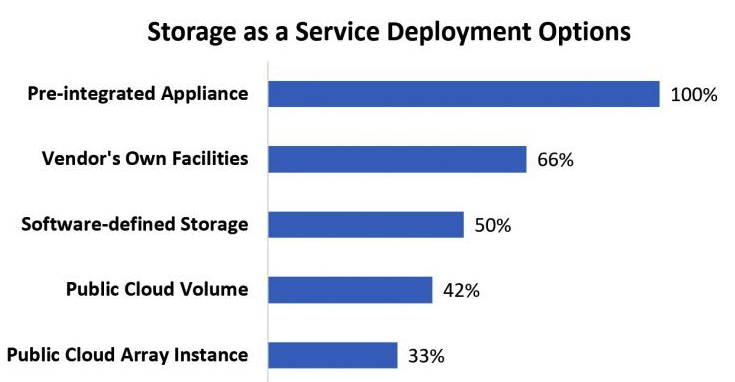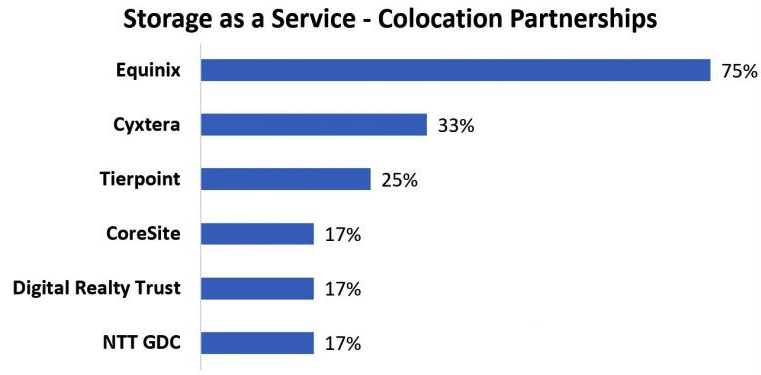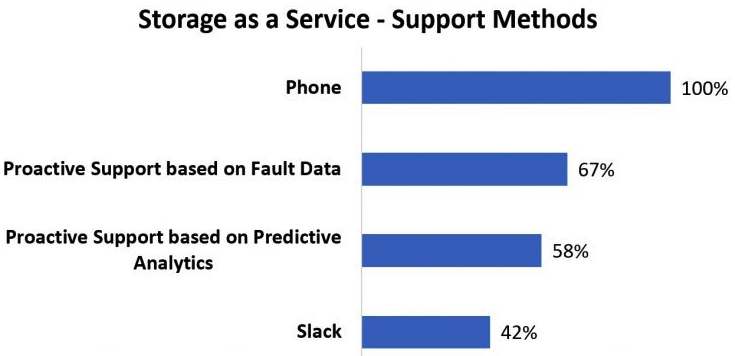Research Into Storage as-a-Service
Equinix standout colocation partner
This is a Press Release edited by StorageNewsletter.com on June 28, 2022 at 2:04 pm This article, published on June 23, 2022, was written by Ken Clipperton, lead analyst, DCIG, LLC.
This article, published on June 23, 2022, was written by Ken Clipperton, lead analyst, DCIG, LLC.
Observations from DCIG’s Research into Storage as a Service
What is Storage as-a-Service?
DCIG defines storage-as-a-service as a storage consumption model where enterprises purchase storage as a subscription with billing based on storage usage. The specific metrics used to measure that usage vary by vendor, but generally boil down to capacity and performance.
Why Storage as-a-Service?
Many storage vendors are focused on enhancing the ownership experience. New acquisition and deployment options associated with storage as a service give enterprises greater flexibility in deploying enterprise storage capabilities wherever they are needed, without sacrificing the enterprise data services that they have come to rely upon.
While some people look at STaaS primarily as a model for financing infrastructure, others see it as a mechanism to bring the cloud operating model to on-premises storage or as a tactical move to enable them to move workloads to the cloud.
Storage as-a-Service Delivers Many Benefits
A well-executed STaaS deployment should do more than just conserve cash. It should also deliver greater agility and flexibility to support changing business requirements, especially unexpected events that fall within the planning horizon including events as dramatic as a global pandemic or as mundane as a corporate acquisition.
STaaS enables enterprises to avoid the waste associated with the overprovisioning that is part of traditional enterprise storage purchasing process. Thus, it can also contribute to enterprise sustainability goals by enabling more effective use of energy and materials.
With STaaS, organizations can benefit from storage acceleration and scalability of the latest storage systems without having to become experts in those systems. In most cases the vendor is responsible to keep the array available and up to date. Enterprise IT still manages storage volumes for its applications, but the vendor manages the underlying storage system(s). Thus, enterprises directly benefit from the provider’s expertise in managing its solution.
Storage as-a-Service Deployment Options
DCIG asked vendors to identify deployment options for their STaaS solutions.
The most commonly offered deployment option continues to be the pre-integrated appliance, the storage array. The hardware may be the same, but the ownership and management experience can be radically different. In true Opex-based STaaS, the ownership of the hardware remains with the vendor. Some vendors take complete responsibility for the hardware, including the installation of software and firmware updates, and providing on-site service to replace failed components.
Enterprises can also deploy half of the solutions DCIG researched as SDS running on the enterprise’s preferred server hardware. This can simplify infrastructure management across the entire lifecycle from acquisition to decommissioning.
Five of the 12 solutions can be consumed in the public cloud either as a public cloud volume or as an array instance in the public cloud. This option enables very rapid deployment, in some cases nearly instantaneously directly from the cloud provider’s standard management console or application store.
Surprisingly, 8 of the 12 vendors surveyed indicated that they offer STaaS deployment of their solution in the vendor’s own facilities. In this case, the vendor has ready access to both the hardware and software.

Storage as-a-Service Colocation Partnerships
DCIG asked: “With what colocation facility providers does the vendor have partnerships for this STaaS solution?“
Enterprises can, of course, choose to install a storage system of their choosing with any colocation provider they wish. However, when the vendor has a partnership with a colocation provider, additional benefits may accrue to the enterprise. These include pre-positioning storage systems in the colocation facility to enable rapid deployment and expansion of physical assets in support of the STaaS agreement.
Equinix was the standout colocation partner in this research, with 9 of the 12 solution providers indicating they have a partnership in place. Four the 12 identified Cyxtera, and 3 Tierpoint, as a colocation partner. Other providers mentioned include China Telecom, China Unicom, CoreSite, Digital Realty Trust, Global Switch, NTT GDC, and Sungard.

Methods to Obtain Support
With the solution provider or one of their VARs taking on primary responsibility for managing the STaaS solution, the mechanisms for obtaining support and communicating with the provider take on additional importance.
DCIG asked: “What methods are available to contact or obtain support?“
All vendors, of course, offer reactive support 24x7x365 via the phone. The two-thirds of the solution providers also offer proactive support based on fault data, and the majority also offer proactive support based on predictive analytics. These proactive services enable vendors to notify IT staff of issues even before operations are disrupted and in many cases intervene directly to keep storage services available to applications. In fact, some vendors guarantee 100% data availability for the STaaS solutions.
Many vendors provide their enterprise customers with access to support engineers via Slack. This instant communications channel can add significant value to enterprise IT staff by delivering more responsive service from the vendor.

Available Consulting Services
DCIG asked: “What additional value-added services does the vendor offer with this product?“
All offer consulting services, and 8/12 offer data migration services. This is significant because migration planning an execution often takes enterprises a year or more. Expert migration assistance can speed the migration, enabling applications to experience the performance benefits of the new solution sooner and the enterprise to decommission old systems more quickly.
Beyond Storage as-a-Service
DCIG asked: “What other elements of data center infrastructure are offered as a service alongside this STaaS solution?“
The majority of vendors have extended their as a service offerings beyond storage to include both compute and networking as a service. Nine of the 12 provide virtual servers, 8 do bare metal servers, and 7 offer container support in their as a service offerings. This can bring as a service benefits to more of the overall enterprise infrastructure, adding even more to the agility and flexibility enterprises need to respond to changing conditions and priorities.














 Subscribe to our free daily newsletter
Subscribe to our free daily newsletter

